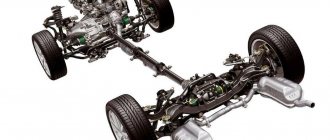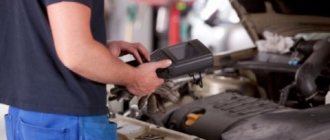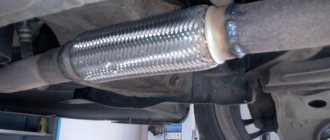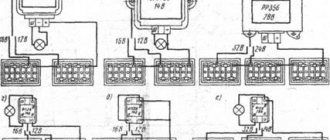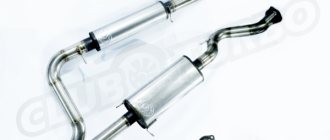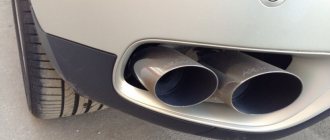Home / Exhaust system / Exhaust system diagnostics and malfunctions
Many car enthusiasts do not attach importance to minor malfunctions of the car's exhaust gas removal system. In this case, problems with the exhaust system can result in expensive engine repairs, poisoning of passengers with exhaust gases, and even a fire. This is a rather complex system, the operation of which is closely related to the rest of the car.
Exhaust system diagnostics carried out by the “Your Muffler” service will save you from many expensive breakdowns. Any malfunction is easier to prevent, and a problem detected in time is eliminated for a smaller amount. You can check the car either at a service station during scheduled maintenance or on your own.
Signs of a Malfunctioning Exhaust System
The exhaust system consists of several parts, each of which plays an important role. These include the exhaust pipe, catalyst, resonator and the muffler itself. The main functions it performs are noise reduction and reduction in the emission of harmful gases. Also, there is often a corrugation on the receiving pipe, designed to reduce vibration. A malfunction of any part of the exhaust system can affect the condition of the entire car and many other parts in particular, so it is necessary to regularly diagnose this element of the car.
IMPORTANT! Exhaust gases entering the cabin are extremely dangerous to health, since they contain a huge amount of harmful substances. Therefore, before any long trip, it is necessary to visit a car service to inspect the exhaust system.
Exhaust system - main components and elements
One of the main elements of the exhaust system is the manifold. Using this unit, the system can remove exhaust gases from the combustion chamber. This waste enters special tubes that serve as intermediate links in the process of removing gases to the outside. It is the collector that is subjected to tuning by specialists in order to provide the cylinders with more fuel, thereby increasing engine power.
After the manifold comes the catalytic converter. This unit helps ensure that exhaust gases have a lower level of toxicity. If you look at the cross-section of the catalyst structure, you will see an outer ceramic shell, which consists of thin channels. Inside, these channels are covered with a tiny layer of platinum. Instead of platinum, rarer metals may well be used. For example, palladium or rhodium.
Attention! Due to the fact that expensive materials are used in the manufacture of the catalyst, its cost is also expensive.
After the catalyst there is a resonator. Its main task is a sharp expansion of exhaust gases. Thanks to this process, the back pressure of the exhaust channel is reduced and the shock wave is softened. The last component that a car exhaust system has is the muffler. It is this part that is responsible for the sound produced by the machine. Today, three types of this node are used:
- Reflector;
- Limiter;
- Absorber.
Article on the topic: Easy replacement of brake pads on a Lacetti
Now that you have an idea of what the car exhaust system is like, you can consider how the system works.
How often does a muffler need to be repaired?
As a rule, with careful operation of the vehicle and regular visits to the car service center, muffler repair work is performed extremely rarely, but for this it is necessary to contact the service center in a timely manner at the slightest suspicion of any malfunction in the operation of the exhaust system.
IMPORTANT! Do not forget that the operation of the muffler directly affects the operation of many other systems in the car, therefore any malfunction in the operation of this element can lead to additional, often more critical, malfunctions in other systems.
Replacement for VAZ 2110/2112
Tools required for changing on tenth generation VAZ cars:
Dismantling the old
The vehicle must be on a flat, hard surface before starting work. You can drive it out of the garage and get to work on removal.
The gear shift lever is moved to “park”
Wheel chocks are installed under the wheels of the car to prevent the car from moving.
The car is jacked up and placed on trestles to facilitate access to the exhaust system
The car is carefully lowered onto the trestles and securely secured to them
On tenth generation VAZ cars, the muffler is located under the bottom in front of the rear axle
The muffler is secured with two clips on the front and rear
The muffler and exhaust pipe are separated, and the joints are cleaned of dirt and rust.
Installing a new
The process of installing a new muffler is similar to the dismantling process, only it is carried out in the reverse order. In this case, it is necessary to observe certain nuances:
A cutting tool is used to straighten the end of the exhaust pipe before installing the muffler.
The diameter of the exhaust pipe is adjusted to the size of the muffler
The new muffler is installed on the fasteners from the old muffler
The ends of the exhaust pipe and muffler are coated with sealant
New fasteners for the muffler are installed in place, but are not tightened
A new muffler is inserted into the exhaust pipe
The clamps at the junction of the muffler and exhaust pipe are tightened with a ratchet
The clamp nuts are tightened all the way
Replacement features
How to repair a muffler
If your car's muffler requires repair or complete replacement, it is not recommended to do this work yourself, since there is a high risk that you will only worsen the condition of the exhaust system, and possibly the entire vehicle as a whole. In order to prevent such a situation, contact only specialized car services. In our car service center, qualified specialists with the necessary competence in the field of working with exhaust systems will competently diagnose the exhaust system of your car, and, if necessary, repair or install a new muffler in the shortest possible time.
IMPORTANT! Do not delay repairs as this may worsen the condition of the entire exhaust system and incur additional costs.
If you encounter any malfunction in the exhaust system and you need to diagnose it, repair it or replace the muffler, then our salon specialists will be happy to help you with this, since we carry out all types of this work!
| Name | Price |
| Car diagnostics on a lift | For free |
| Repair of standard muffler | from 500 rubles |
| Resonator installation | from 600 rubles |
| Installing a flame arrester | from 1200 rubles |
| Replacing corrugations | from 1500 rubles |
| Replacing rings and gaskets | from 300 rubles |
| Exhaust manifold replacement | from 2,500 rubles |
| Replacing the lambda probe | from 500 rubles |
| Crack repair | from 500 rubles |
Exhaust system repair
This year the car muffler will celebrate the 113th anniversary of its birth. In 1894, a Panhard-Levassor car was for the first time equipped with such a part as an exhaust muffler. The exhaust system, in other words, the exhaust system, is a system of elements, starting from the exhaust manifold and ending with mufflers, which is designed to remove exhaust working gases, burn out unburned fuel particles and reduce noise levels.
Frankly speaking, without it the engine power would seriously increase. But alas, there is no other way out than simply keeping the exhaust system in good working order. There are quite a lot of aggressive substances in the exhaust gases, especially in the exhaust gases obtained as a result of burning low-quality diesel fuel. There is no need to be afraid for the environment; the gases released by burps of domestic animals cause more damage to the environment than all the cars in the world. But due to the caustic nature of the condensate, the walls of the exhaust system are destroyed; over time, corrosion can corrode the mufflers so much that to pierce it, it will be enough to simply poke it with your finger.
Needless to say, it will be no less sensitive to impacts on bumps and potholes on the road? The most common malfunctions of exhaust systems:
- Catalyst malfunctions. As a result of its damage, the permeability of the exhaust gases deteriorates and, consequently, engine power decreases. It is not subject to repair or restoration work, so it is changed, replaced with an emulator, or simply cut out from the general circuit.
- Oxygen sensor malfunction. The oxygen sensor is the most vulnerable element of the exhaust system and at the same time is one of its most important parts, since it is part of the engine management system. Among its malfunctions are heater malfunctions, burnout and subsequent destruction of the ceramic tip and contact failure. Its malfunction is determined using a self-diagnosis system, and the reasons for its failure are low-quality fuel and the presence of oil vapor in the exhaust gases.
- Muffler malfunctions. They are quite easy to identify with the naked eye and also by ear. When the muffler is faulty, you can clearly hear it from the outside - the noise level increases sharply.
The hopeless elements of the exhaust system are simply replaced with new ones. To do this, all threaded connections are lubricated with penetrating lubricant, they are allowed to acidify, the mounting pads are removed and the connecting bolts of the flanges are unscrewed. The damaged area is replaced with a new one. But repairing, replacing and cleaning such an element of the exhaust system as the exhaust manifold requires a fairly large amount of fitting work. In some cases, you can do without replacing the damaged area. For example, holes formed as a result of hitting a stone can be repaired with a patch made of varnished fabric; soldering and welding work bring quite good results. Although it is worth recognizing that this place will still remain the most vulnerable. Also, when repairing minor damage, you can get by using a special sealant. Therefore, before starting repair work, you should make sure that repairing a particular component of the exhaust system will be worth the cost, or it is worthwhile to replace the damaged area with a new one.
1 - housing 2 - partitions 3 - gas tubes 4 - microresonator 5 - covers 6 - intake manifold 7 - exhaust manifold
When operating a car in a modern city, frequent short trips in a car that is usually not fully warmed up or many hours of languishing in traffic jams lead to the fact that the rear part of the muffler is not able to properly heat up and dry out, and as a result, in its body gradually more and more water accumulates. Additionally, the process of corrosion of the main muffler is spurred on by the accumulation in its atmosphere of a large amount of residues of incompletely burned fuel, entering into an oxidative reaction with the moisture accumulated in the muffler body, it turns the latter into a powerful electrolyte. Therefore, unlike fish, the exhaust system begins to rot from the “tail”. To some extent, special drainage holes made in the lower part of the main muffler housing help to correct this situation, through which water that gets inside the muffler housing is drained.
| Similar articles | Popular articles | Selected articles |
|
|
|

